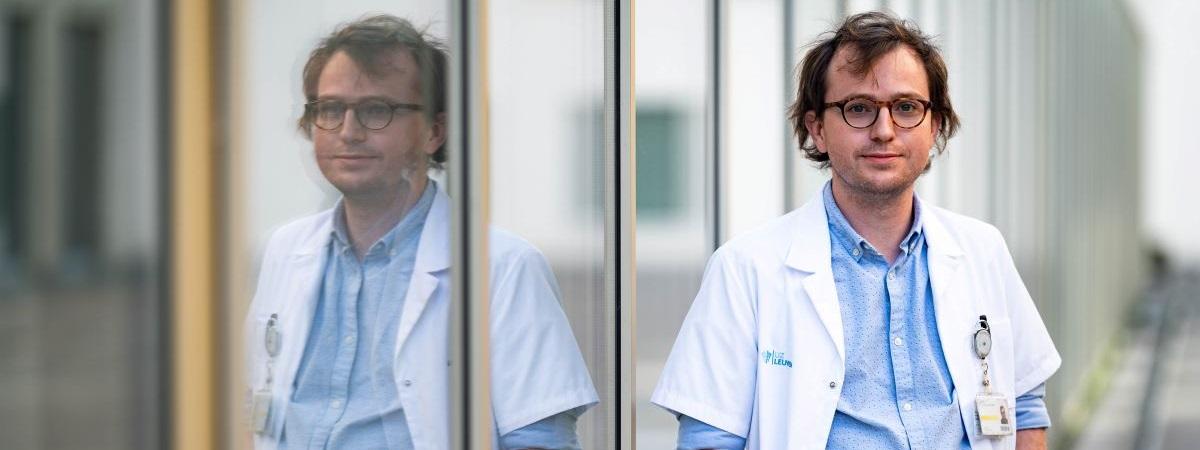Where medicine meets technology
Mission Lucidity embraces interdisciplinary collaboration across borders. One of our major aims is to connect fundamental scientists, engineers and clinicians and stimulate them to work on innovative projects. However, every now and then, as a bonus, you find all of those specialties in one person. Meet Dr. Hannes Heylen, psychiatrist in training and biomedical engineer, who recently joined our brain stimulation project as a PhD student.

What inspired you to work at the crossroads between medicine and technology?
I graduated as a medical doctor in 2015 and started my residency in psychiatry right after, but technology and engineering had also been fascinating me for a long while. So I decided to pause my residency and pursue an additional master’s degree in biomedical engineering, which I completed in 2018.
During the engineering master’s, I was fortunate to be selected for an internship at Johns Hopkins University in Baltimore, on the East Coast of the United States. Over the summer, I worked in the research group of Prof. Jiande Chen on a very exciting neurostimulation project. It was thoroughly explorative and experimental. We stimulated the sacral nerves in the spinal cord of a rat model for inflammatory bowel disease and investigated which disease features were beneficially affected. This enriching experience connected two of my passions; medicine and electrical engineering, and really spurred me to continue in interdisciplinary research.
As a result, I did not hesitate when I got the opportunity to work on Mission Lucidity’s brain stimulation project. I’m working in the team as a joint PhD student at both the science & technology and the biomedical doctoral schools of KU Leuven, while still doing clinical work for one day a week as part of my ongoing medical training in psychiatry.
What are the goals and ambitions of the brain stimulation project?
Given that drug development for neurodegenerative diseases has been particularly challenging, researchers are increasingly exploring alternative therapies. Brain stimulation holds promise and has already been put to use for a while, for instance to relieve some of the motor symptoms in Parkinson’s disease patients. In our project, we are developing a new method of brain stimulation that is minimally invasive and induces changes in selected brain regions, intended to result in enhanced cognition or delayed cognitive decline. We are still at an early experimental and preclinical phase, but ultimately we want to develop a brain stimulation tool that could be used to treat Alzheimer’s disease and other types of dementia.
Our main focus is on developing and exploring the possible benefits of ‘temporally interfering field’ stimulation. This is a brand new strategy invented by our research collaborator Nir Grossman (UK Dementia Research Institute, Imperial College London) that looks very promising, but we’re also considering other approaches based on existing stimulation methods. It’s possible that one size does not fit all: the specific stimulation paradigm may need to be tailored to the individual patient or a particular disease state.
It’s great to live in this 21st century where interdisciplinary research is central. We are on the verge of some fascinating innovations that will have such a significant impact on the quality of life of our patients.
What is your specific role in the project?
I will mostly work in the Electronic Circuits and Systems lab at KU Leuven and imec under supervision of Prof. Chris Van Hoof, where my main goal will be to design and develop a new device to apply this type of innovative brain stimulation.
At the moment I’m still getting to know everyone and mainly reading up on the recent literature. I’m tracking what’s already been done and what is known about brain stimulation in the context of neurodegenerative diseases. What stimulation models exist and what insights should we definitely keep in mind when developing our own stimulation device?
The technological development will happen in close collaboration with fundamental scientists who perform modelling of the stimulation effects (Prof. Myles McLaughlin) and experimental research in lab animals (Prof. Peter Janssen), as well as with psychiatrists (Prof. Dr. Mathieu Vandenbulcke) and neurosurgeons (Prof. Dr. Tom Theys) who provide clinical insights.
How do you experience that interdisciplinary collaboration in Leuven?
We truly have top-notch expertise in electrical engineering, fundamental neuroscience and clinical care in Leuven. There’s a lot of know-how densely packed in our city – without forgetting our international partners. Bringing together all of our respective visions and backgrounds to create one device for the clinic: I find that utterly fascinating. 1+1 really does not equal 2 in this case, but 3, and I hope I can play an important role in that difference, that added value.
Our project is very technical, but also very human. Moreover, it’s about diseases affecting cognition, which have a huge impact on society and about which we are rightly very concerned. We’re all getting older, so the prevalence of cognitive disorders keeps increasing, and we all want to be in good health for as long as possible. It’s great to live in this 21st century where interdisciplinary research is central. We are on the verge of some fascinating innovations that will have such a significant impact on the quality of life of our patients.
Read more about Mission Lucidity's brain stimulation project